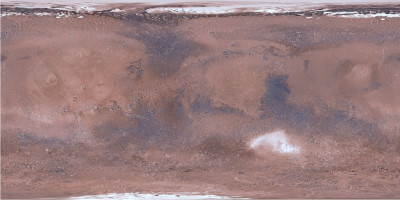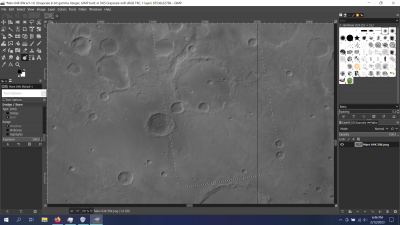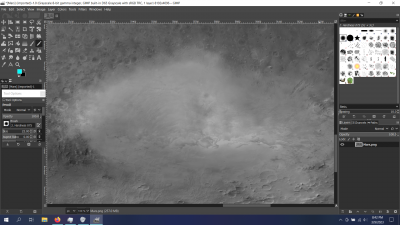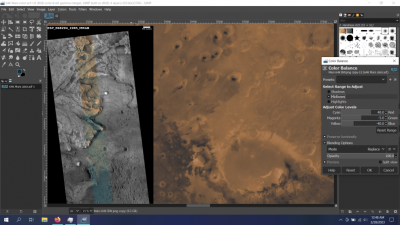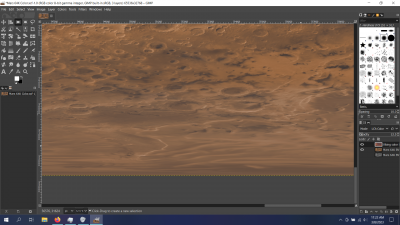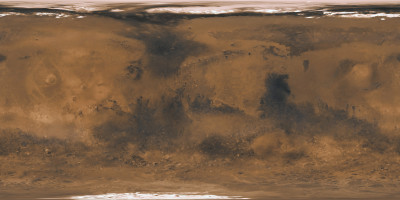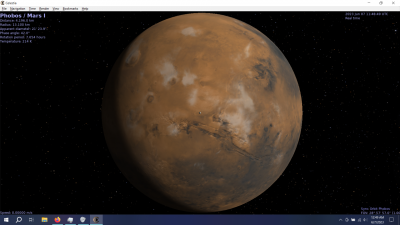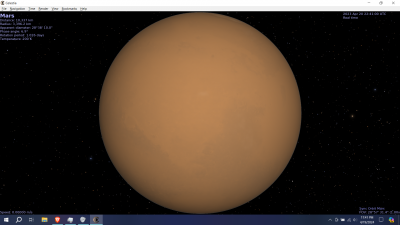The first 64K Mars color texture: A journey in texture making
-
Topic authorShadow-Dragon-777
- Posts: 71
- Joined: 03.11.2021
- Age: 30
- With us: 2 years 6 months
- Location: A Galaxy Far Far Away....
The first 64K Mars color texture: A journey in texture making
I have decided to make a topic chronicling my development of the first 64K color texture of Mars which will be releasing later this month. In all of the Internet, I have not found a single 64K or more texture of Mars. Celestia Origin interestingly omits Mars in it's 64K texture yet it's the most explored planet in the solar system. A 64K+ texture does exist on the USGS, however, this texture is horribly and I mean HORRIBLY colored. Not to mention its from the Viking probes which typical of older probes, had contrast issues and Mars has changed drastically since:
My first task was to find a global map of Mars from a more recent probe. It turned out, the Mars Global Surveyor has a mosaic that is 96K. Good, images from 1999 (still there has been two global dust storms since). I downloaded this mosaic. I tried to find a color map to go with it but could find none, at least not newer than Viking sadly. The MGS took color pictures but they were never assembled into a mosaic.
Upon closer inspection... I noticed a huge mess. There were gaps in the imagery in places. There were dust storms inadvertently included in the maps. There was a region of discolored imagery between 60-65 South, there were image discontinuities around the north polar cap and 55 South. There was a lot of work to do if I was to make this usable...
My first task was to find a global map of Mars from a more recent probe. It turned out, the Mars Global Surveyor has a mosaic that is 96K. Good, images from 1999 (still there has been two global dust storms since). I downloaded this mosaic. I tried to find a color map to go with it but could find none, at least not newer than Viking sadly. The MGS took color pictures but they were never assembled into a mosaic.
Upon closer inspection... I noticed a huge mess. There were gaps in the imagery in places. There were dust storms inadvertently included in the maps. There was a region of discolored imagery between 60-65 South, there were image discontinuities around the north polar cap and 55 South. There was a lot of work to do if I was to make this usable...
Last edited by Shadow-Dragon-777 on 09.03.2023, 16:53, edited 1 time in total.
-
Topic authorShadow-Dragon-777
- Posts: 71
- Joined: 03.11.2021
- Age: 30
- With us: 2 years 6 months
- Location: A Galaxy Far Far Away....
-
Topic authorShadow-Dragon-777
- Posts: 71
- Joined: 03.11.2021
- Age: 30
- With us: 2 years 6 months
- Location: A Galaxy Far Far Away....
THEMIS IR is infrared though, it will look incorrect to visible light much like Magellan Venus data.
EDIT:
MRO data has been compiled in CTX mosaic but it's uncontrolled and thus lighting is a mess in it. MEX does not have a finished global mosaic as they seem to have given up work on one years ago.
EDIT:
MRO data has been compiled in CTX mosaic but it's uncontrolled and thus lighting is a mess in it. MEX does not have a finished global mosaic as they seem to have given up work on one years ago.
Last edited by Shadow-Dragon-777 on 10.03.2023, 01:45, edited 1 time in total.
- cartrite
- Posts: 1976
- Joined: 15.09.2005
- With us: 18 years 7 months
- Location: Pocono Mountains, Pennsylvania, USA Greate Grandfother from Irshava, Zakarpattia Oblast Ukraine
Your latest and greatest is data from MRO. The software from USGS called ISIS and another called GDAL is what I used in the past. MEX is another good data source.
VivoBook_ASUSLaptop X712JA_S712JA Intel(R) UHD Graphics 8gb ram. Intel(R) Core(TM) i5-1035G1 CPU @ 1.00GHz, 1190 Mhz, 4 Core(s), 8 Logical Processor(s) 8 GB ram. Running on Windows 11 and OpenSuse 15.4
-
Topic authorShadow-Dragon-777
- Posts: 71
- Joined: 03.11.2021
- Age: 30
- With us: 2 years 6 months
- Location: A Galaxy Far Far Away....
PART 2:
With a mess of a map and no better more recent options. I got to work in fixing up this map. I managed to find a lower resolution version of the map with coverage in the areas with no coverage and blend those in. My next step was getting rid of the image irregularities and seams.
For the 60-65S image artifact, I used contrast corrections, then gimps shading and burn tool to fix it. Next up were the hundreds of irregular lighting artifacts. Using gimps burn/dodge tool and blur, I corrected the lighting in these areas then blurred the seams.
This is an example of about a few hundred of these image artifacts. This took about a hundred hours when I spent when I needed a break from other Grand Tour addons. Following this, there were three dust storms on the map, one in Hellas making it as bright as the polar caps, one in Sirenum, and one near Argyre. With Gimp's soft light layer and a Viking layer, I used a soft brush to accentuate terrain details beneath the dust storms, then I used the burn tool to make Hellas darker and at least more align with the brightness of the Tharsis or Arabia regions than the ice caps as seen from Earth. The albedo of Hellas is variable because of it being a frequent area of dust storms.
The next step was to color this black and white map... What a mammoth task for a colorful planet like Mars!!!
With a mess of a map and no better more recent options. I got to work in fixing up this map. I managed to find a lower resolution version of the map with coverage in the areas with no coverage and blend those in. My next step was getting rid of the image irregularities and seams.
For the 60-65S image artifact, I used contrast corrections, then gimps shading and burn tool to fix it. Next up were the hundreds of irregular lighting artifacts. Using gimps burn/dodge tool and blur, I corrected the lighting in these areas then blurred the seams.
This is an example of about a few hundred of these image artifacts. This took about a hundred hours when I spent when I needed a break from other Grand Tour addons. Following this, there were three dust storms on the map, one in Hellas making it as bright as the polar caps, one in Sirenum, and one near Argyre. With Gimp's soft light layer and a Viking layer, I used a soft brush to accentuate terrain details beneath the dust storms, then I used the burn tool to make Hellas darker and at least more align with the brightness of the Tharsis or Arabia regions than the ice caps as seen from Earth. The albedo of Hellas is variable because of it being a frequent area of dust storms.
The next step was to color this black and white map... What a mammoth task for a colorful planet like Mars!!!
-
Topic authorShadow-Dragon-777
- Posts: 71
- Joined: 03.11.2021
- Age: 30
- With us: 2 years 6 months
- Location: A Galaxy Far Far Away....
Yes, but Themis sees the temperature of a place, not how it looks if we looked at it with our eyes. An area with a lot of rocks will look darker than an area with a lot of sand because rocks absorb heat over less of a surface area than sand of equivalent volume. Also areas with brighter soil will appear darker in the THEMIS map as they absorb less heat. It may have good resolution but it isn't what we would see on Mars with our eyes. (THEMIS does have a visible light camera that sees Mars as we would but imagery from that camera has not been mapped)
Shadow-Dragon-777 wrote:Yes, but Themis sees the temperature of a place, not how it looks if we looked at it with our eyes.
That's true. That is why I used visible light images for VT layers at 16k, 32k and 64k. THEMIS is perfectly in sync with them at 128k and 256k and THEMIS can show unbelievable details.
-
Topic authorShadow-Dragon-777
- Posts: 71
- Joined: 03.11.2021
- Age: 30
- With us: 2 years 6 months
- Location: A Galaxy Far Far Away....
PART 3:
With a BW map cleaned out of most issues, the next task was to add detail to areas with spacecraft. Using a MRO mosaic (though not photo corrected) I added detail to areas where spacecraft have been located on Mars including:Mars 3, Viking 1, Viking 2, Pathfinder, Beagle 2, Spirit, Opportunity, Phoenix, Curiosity, Schiaparelli, InSight, Zhurong, and Perseverance. One of the coolest features GIMP has is the color balance tool. The first thing I did was take color from MRO Hirise images of light and dark transition areas, then use the color of the dark area over the whole planet. The next task was to use the color balance tool to redden the lighter areas as Mars dust has a similar color overall globally. The next step was to then color the ice caps separately. The icecaps have a magenta tinge to them from dust. I added this in a duplicate layer using the balance tool then used a layer mask to 75 latitude and up to prevent this from affecting brighter areas of dust in Hellas and Tharsis. For none-ice cap covered areas of the poles, it gives off a slight magenta tinge as if there is frost there.
This was not enough. The next step was to give it variation. Because this map was colored by brightness, it was lacking variation. There was however a Viking map with color, the Viking red velvet ant map as I like to call it. It was enhanced color but I can fix that by making it at 12.5 percent strength. With this, it allowed me to add variations to color. And after 200 hours of work, I had this giant beautiful 64K map of Mars in true color as it appeared in the early 2000's and with the most recent pole to pole mosaics I could find. Hopefully one day we can get a photocorrected mosaic from the MRO, Odyssey, or MEX to use. Until then it beats having mosaics dating to the 70's for once by a great margin given Mars has a facelift every two decades. This texture will be released in a beta release of Mars in the next couple weeks.
With a BW map cleaned out of most issues, the next task was to add detail to areas with spacecraft. Using a MRO mosaic (though not photo corrected) I added detail to areas where spacecraft have been located on Mars including:Mars 3, Viking 1, Viking 2, Pathfinder, Beagle 2, Spirit, Opportunity, Phoenix, Curiosity, Schiaparelli, InSight, Zhurong, and Perseverance. One of the coolest features GIMP has is the color balance tool. The first thing I did was take color from MRO Hirise images of light and dark transition areas, then use the color of the dark area over the whole planet. The next task was to use the color balance tool to redden the lighter areas as Mars dust has a similar color overall globally. The next step was to then color the ice caps separately. The icecaps have a magenta tinge to them from dust. I added this in a duplicate layer using the balance tool then used a layer mask to 75 latitude and up to prevent this from affecting brighter areas of dust in Hellas and Tharsis. For none-ice cap covered areas of the poles, it gives off a slight magenta tinge as if there is frost there.
This was not enough. The next step was to give it variation. Because this map was colored by brightness, it was lacking variation. There was however a Viking map with color, the Viking red velvet ant map as I like to call it. It was enhanced color but I can fix that by making it at 12.5 percent strength. With this, it allowed me to add variations to color. And after 200 hours of work, I had this giant beautiful 64K map of Mars in true color as it appeared in the early 2000's and with the most recent pole to pole mosaics I could find. Hopefully one day we can get a photocorrected mosaic from the MRO, Odyssey, or MEX to use. Until then it beats having mosaics dating to the 70's for once by a great margin given Mars has a facelift every two decades. This texture will be released in a beta release of Mars in the next couple weeks.
-
Topic authorShadow-Dragon-777
- Posts: 71
- Joined: 03.11.2021
- Age: 30
- With us: 2 years 6 months
- Location: A Galaxy Far Far Away....
Part 4: With my base 64K map finished, I noticed the default Mars clouds are terrible. Even Origin and Echoes' clouds are terrible and don't look like realistic Mars clouds. I noticed the USGS had global mosaics of Martian weather from the MRO MARCI camera. Problem with these clouds is they move and there's holes in the data which I had to fill in with several layers.
After several hours of work and finding suitable 8K mosaics, I then noticed the images were 16 bit which is unusable for Celestia. I then upscaled it to 16K and made it 8 bit, then I added slight blue color. A few days of effort leading to natural Mars clouds in 16K beauty!!! Finally it was time to make the clouds not superrotate and the effect is realistic!!!
It had come to my attention that Phil Stooke, a person renowned for his excellent works on irregular objects and atlases on Mars landers, constructed a map on images collected from Mariner 4, 6, and 7. I was fascinated because these three primitive missions were able to image Mars before a global dust storm occurred and changed the planet's albedo features permanently by the time Mars 2,3 and Mariner 9 arrived. I decided to get work re projecting this map, then I determined which mosaic had better imagery out of Mariner 6 or 7. After that I adjusted the albedo and colorized it similarly to the main mosaic. The result is a fairly well colored mosaic of Mars as it appeared in the 60's using all knowledge.
After several hours of work and finding suitable 8K mosaics, I then noticed the images were 16 bit which is unusable for Celestia. I then upscaled it to 16K and made it 8 bit, then I added slight blue color. A few days of effort leading to natural Mars clouds in 16K beauty!!! Finally it was time to make the clouds not superrotate and the effect is realistic!!!
It had come to my attention that Phil Stooke, a person renowned for his excellent works on irregular objects and atlases on Mars landers, constructed a map on images collected from Mariner 4, 6, and 7. I was fascinated because these three primitive missions were able to image Mars before a global dust storm occurred and changed the planet's albedo features permanently by the time Mars 2,3 and Mariner 9 arrived. I decided to get work re projecting this map, then I determined which mosaic had better imagery out of Mariner 6 or 7. After that I adjusted the albedo and colorized it similarly to the main mosaic. The result is a fairly well colored mosaic of Mars as it appeared in the 60's using all knowledge.
-
Topic authorShadow-Dragon-777
- Posts: 71
- Joined: 03.11.2021
- Age: 30
- With us: 2 years 6 months
- Location: A Galaxy Far Far Away....
A couple weeks ago I got the idea of making a Mars dust storm atmospheric layer. The problem is, objects cannot have more than one cloud layer. Thankfully there is a workaround for this. By creating an invisible non interactive diffuse object slightly larger than Mars, I can give it a cloud layer and using an elevation map, made a 16K map of Mars when it has a dusty fit and only Tharsis pokes out of the haze of dust. There is a tinge of transparency so you may be able to spot major albedo features. This is because Hubble and MRO were able to barely pick out albedo features during the 2018 dust storm that snuffed out poor Opportunity. These global dust storms will be programmed to appear during actual times the planet was recorded to have been entirely covered in dust. Outside those timeframes, the planet will have a couple regional dust storms, the map of which I am still working on.
- John Van Vliet
- Posts: 2940
- Joined: 28.08.2002
- With us: 21 years 8 months
i have been slowley working with this aprox 8 terabyte dataset for a 128 k map
https://murray-lab.caltech.edu/CTX/V01/tiles/
a 3d prespictive
https://murray-lab.caltech.edu/CTX/V01/SceneView/MurrayLabCTXmosaic.html
https://murray-lab.caltech.edu/CTX/V01/tiles/
a 3d prespictive
https://murray-lab.caltech.edu/CTX/V01/SceneView/MurrayLabCTXmosaic.html

